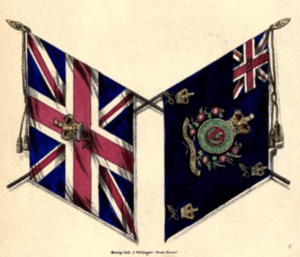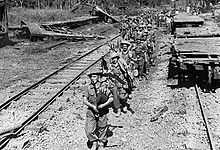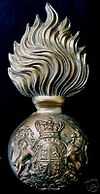Royal Scots Fusiliers
| The Royal Scots Fusiliers | |
|---|---|
|
Regimental cap badge | |
| Active | 1678–1959 |
| Country |
|
| Branch | British Army |
| Type | Line infantry |
| Part of | Lowland Brigade |
| Garrison/HQ | Churchill Barracks, Ayr |
| Insignia | |
| Hackle | White |
| Tartan | Hunting Erskine |
The Royal Scots Fusiliers was a line infantry regiment of the British Army that existed from 1678 until 1959 when it was amalgamated with the Highland Light Infantry to form the Royal Highland Fusiliers which was later itself amalgamated with the Royal Scots, the King's Own Scottish Borderers, the Black Watch, the Argyll and Sutherland Highlanders and The Highlanders to form The Royal Regiment of Scotland, with the Royal Highland Fusiliers becoming the 2nd Battalion of the new large regiment.
History
.jpg)
The Earl of Mar's Regiment of Foot ('Mar's Grey Breeks') (1678–1695)
The regiment was raised in Scotland in 1678 by Stuart loyalist Charles Erskine, de jure 5th Earl of Mar for service against the rebel covenanting forces during the Second Whig Revolt (1678–1679). It was used to keep the peace and put down brigands, mercenaries, and rebels. In the Glorious Revolution of 1689, the regiment was ordered south. Initially, it stayed loyal to James II of England; however, when he fled to Ireland, it opted to serve Prince William of Orange. Ironically, the regiment later fought against the Jacobites during the Second Jacobite Rebellion (1745) at the Battle of Culloden in 1746.
The Scots Fusilier Regiment of Foot (1695–1712)
The regiment was converted to fusiliers in 1689, but didn't receive the title officially until 1695. It was nicknamed the "Duke of Marlborough's Own" for its excellent service in all of the Duke's campaigns in the War of the Spanish Succession and received the title of "Royal" in 1712.
21st (Royal North British Fusilier) Regiment of Foot (1713–1877)
The regiment was renamed the Royal North British Fusilier Regiment of Foot in 1713. It was later numbered the 21st Regiment in 1751, when seniority numbers were introduced.
21st (Royal Scots Fusiliers) Regiment of Foot (1877–1881)
The regiment finally saw the restoration of "Scots" in their title in 1877. Although the use of the name during the Georgian era can be proven by reference to swords carried by senior officers circa 1825.

Childers' reforms of 1881
The regiment did not suffer the indignity of being amalgamated, as it already had two regular battalions. However, it did become the County Regiment of Ayrshire, Dumfriesshire, Kirkcudbrightshire, Roxburghshire, Selkirkshire and Wigtownshire in South-West Scotland. This made them a Lowland Regiment and forced them to adopt trews. It also had to lose its numbering, becoming the Royal Scots Fusiliers.
First World War
The Royal Scots Fusiliers served during the First World War. In raised many service battalions and Territorial Force battalions. This period in the regiment's history is particularly notable, as its 6th Battalion was commanded on the Western Front, by future Prime Minister Winston Churchill.

Second World War
In the Second World War, the regiment served in North-West Europe, Sicily and Italy, Madagascar and Burma. The 1st Battalion spent the whole war as part of the 29th Independent Infantry Brigade Group. The battalion participated in the Battle of Madagascar in 1942 as did the 2nd Battalion, a unique achievement for the regiment to have both its regular battalions involved in the same action. They were then transferred to British India to fight in the South-East Asian Theatre. In 1944 the 29th Brigade became part of the 36th Infantry Division, previously a British Indian Army formation and one of two British divisions fighting the Japanese, the other being the 2nd Infantry Division although many Indian divisions included British units under command. The 36th Division spent the rest of the war under command of the British Fourteenth Army.
The 2nd Battalion served with the 17th Infantry Brigade as part of the 5th Infantry Division. They were sent as an independent brigade group to France in late 1939 to join the rest of the BEF and were involved in the Battle of Dunkirk and had to be evacuated to England. After 2 years spent on home defence in the United Kingdom, the battalion and brigade were detached from the 5th Division, and like the 1st Battalion, fought in Madagascar. The battalion next saw service fighting in Sicily. In 1944 the division fought in the Battle of Anzio in some of the fiercest fighting of the Italian Campaign thus far. The Anzio landings were an attempt to outflank the German Gustav Line, one of many defensive lines the Germans had created across Italy. After the fierce fighting there, the 2nd RSF and the rest of 5th Division were withdrawn, in July 1944, to Palestine to rest and refit. They returned to Italy briefly in early 1945 but were transferred, along with I Canadian Corps from Eighth Army, to Belgium to join the 21st Army Group in the Allied invasion of Germany.
The 4/5th 6th and 11th Battalions all saw service in the European Campaign in 1944-1945 with the 6th also serving in France 1940, assigned to 51st (Highland) Infantry Division and part of the BEF. The 4/5th Battalion was the TA 4th and 5th battalions merged and became part of 156th Infantry Brigade assigned to the 52nd (Lowland) Infantry Division. The 6th Battalion was reassigned to the 46th Infantry Brigade part of 15th (Scottish) Infantry Division, the 2nd Line duplicate of the 52nd, and served with them during the Battle of Normandy as did the 11th Battalion with 147th Infantry Brigade of the 49th (West Riding) Infantry Division. The 11th Battalion was raised in 1940 and joined the 222nd Infantry Brigade.
Amalgamations of 1959
The Royal Scots Fusiliers were amalgamated with the Highland Light Infantry (City of Glasgow Regiment) in 1959 to form The Royal Highland Fusiliers, (Princess Margaret's Own Glasgow and Ayrshire Regiment). The regular 1st battalions of the two Regiments combined at Redford Barracks, Edinburgh to form the 1st battalion of the new regiment (1 RHF).
Battle honours
The Regiment was awarded the following battle honours. Those shown in bold from the two World Wars were those selected to be emblazoned on the King's Colour.
- Blenheim, Ramillies, Oudenarde, Malplaquet, Dettingen, Bellisle, Martinique 1794, Bladensburg, Alma, Inkerman, Sevastopol, South Africa 1879, Burma 1885–87, Tirah, Relief of Ladysmith, South Africa 1899–1902
- The Great War (18 battalions): Mons, Le Cateau, Retreat from Mons, Marne 1914, Aisne 1914, La Bassée 1914, Ypres 1914 '17 '18, Langemarck 1914, Gheluvelt, Nonne Bosschen, Neuve Chapelle, Aubers, Festubert 1915, Loos, Somme 1916 '18, Albert 1916 '18, Bazentin, Delville Wood, Pozières, Flers-Courcelette, Le Transloy, Ancre Heights, Ancre 1916, Arras 1917 '18, Scarpe 1917 '18, Arleux, Messines 1917, Pilckem, Menin Road, Polygon Wood, St Quentin, Bapaume 1918, Rosières, Lys, Estaires, Hazebrouck, Bailleul, Béthune, Scherpenberg, Drocourt-Quéant, Hindenberg Line, Canal du Nord, Courtrai, Selle, France and Flanders 1914–18, Doiran 1917 '18, Macedonia 1916–18, Helles, Gallipoli 1915–16, Rumani, Egypt 1916–17, Gaza, El Mughar, Nebi Samwil, Jerusalem, Jaffa, Tel Asur, Palestine 1917–18
- The Second World War: Defence of Arras, Ypres-Comines Canal, Somme 1940, Withdrawal to Seine, Odon, Fontenay le Pesnil, Cheux, Defence of Rauray, Mont Pincon, Estry, Falaise, Le Vie Crossing, La Touques Crossing, Aart, Nederrijn, Best, Le Havre, Antwerp-Turnhout Canal, Scheldt, South Beveland, Lower Maas, Meijel, Venlo Pocket, Roer, Rhineland, Reichswald, Cleve, Goch, Rhine, Dreirwalde, Uelzen, Bremen, Artlenberg, North-West Europe 1940 '44–45, Landing in Sicily, Sicily 1943, Sangro, Garigliano Crossing, Minturno, Anzio, Advance to Tiber, Italy 1943–44, Madagascar, Middle East 1942, North Arakan, Razabil, Pinwe, Shweli, Mandalay, Burma 1944–45
- 4th Battalion: South Africa 1900–02
- 5th Battalion: South Africa 1900–01

Famous officers
- Sir Andrew Agnew (in command at the Battle of Dettingen)
- Field Marshal Sir Paul Haynes (in command at Inkerman).
- Lord Trenchard (founder of the Royal Air Force and later made Marshal of the Royal Air Force) served as a subaltern during the Second Boer War.
- Deneys Reitz, one time deputy Prime Minister of South Africa and South African High Commissioner in London. Reitz served as a Commando against the British during the Second Boer War, but served on the British side against the Germans in Africa, commanded the 1st Battalion of The Royal Scots Fusiliers from 5 October 1918 to January 1919 in France.
- Sir Winston Churchill, while in disgrace after Gallipoli, commanded the 6th (Service) Battalion of the Regiment from 25 December 1915 until 7 May 1916, near Ypres on the Western Front .
- Churchill's second-in-command was Sir Archibald Sinclair, later made Secretary of State for Air in 1940 as part of Churchill's coalition government.
- One of Churchill's subalterns was Sir Edmund Hakewell Smith. Later, during the Second World War, he would be promoted to Major-General and become commander of 52nd (Lowland) Infantry Division in 1943.
- Thomas Corbett, 2nd Baron Rowallan commanded the 6th (Pioneer) Battalion during the Battle of France.
References
Three histories of the Regiment have been written:
- The History of the Royal Scots Fusiliers 1678–1920 by John Buchan (Lord Tweedsmuir)
- The Royal Scots Fusiliers 1920–1959 by Colonel J C Kemp.
- Cannon, Richard (1849). Historical Record of the Twenty-First or Royal North British Fusilier Regiment of Foot.
| ||||||||||||||||||
